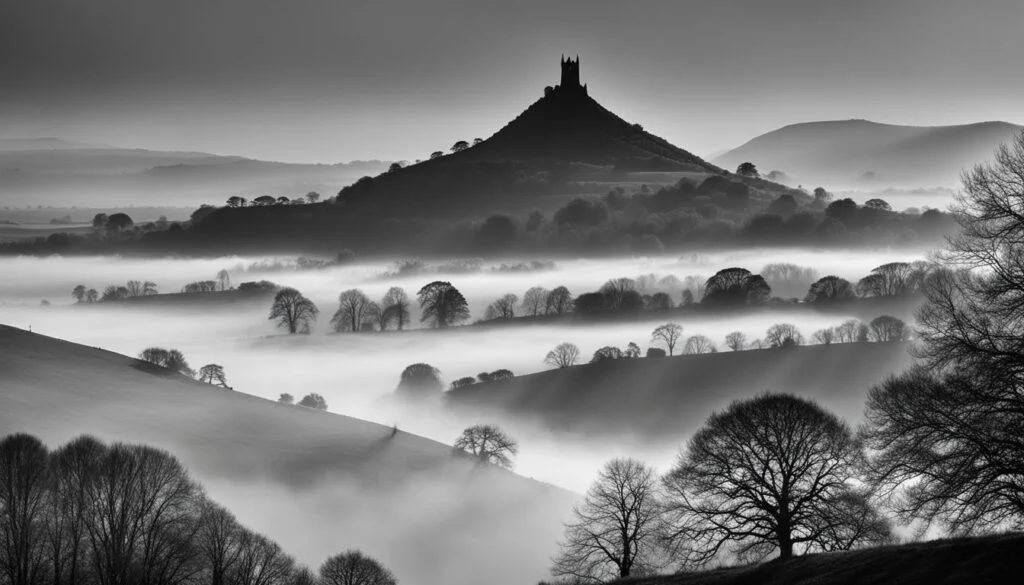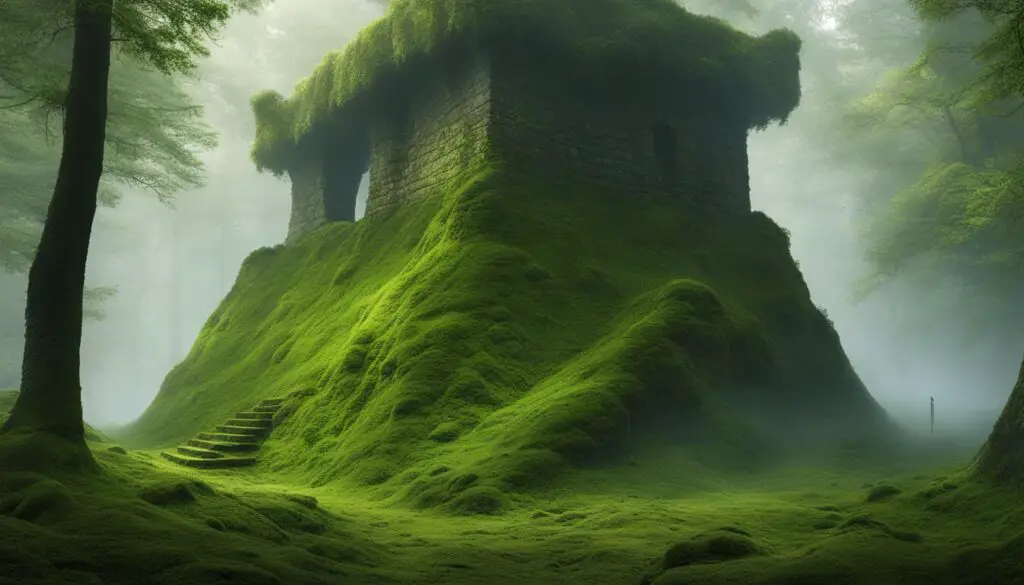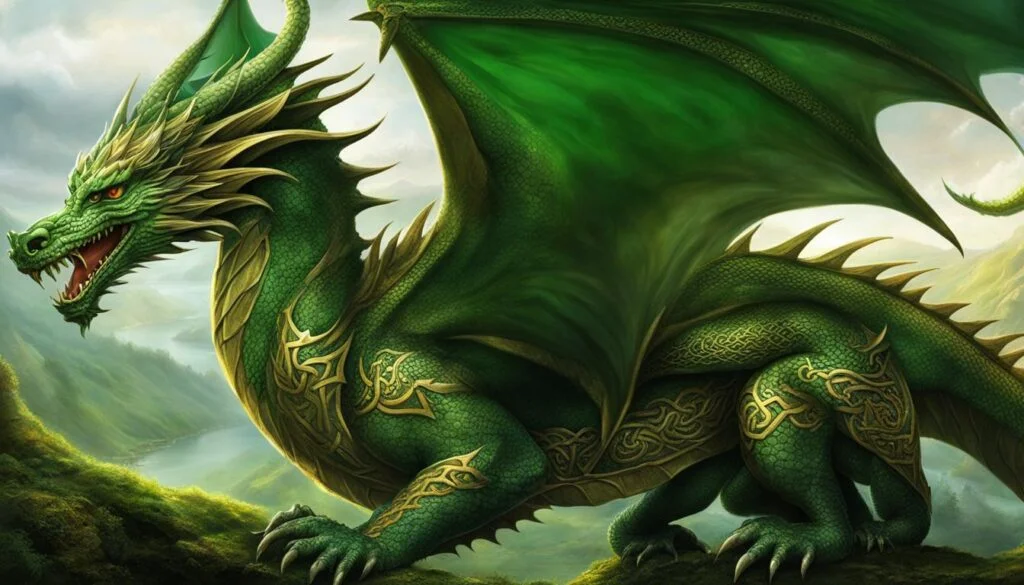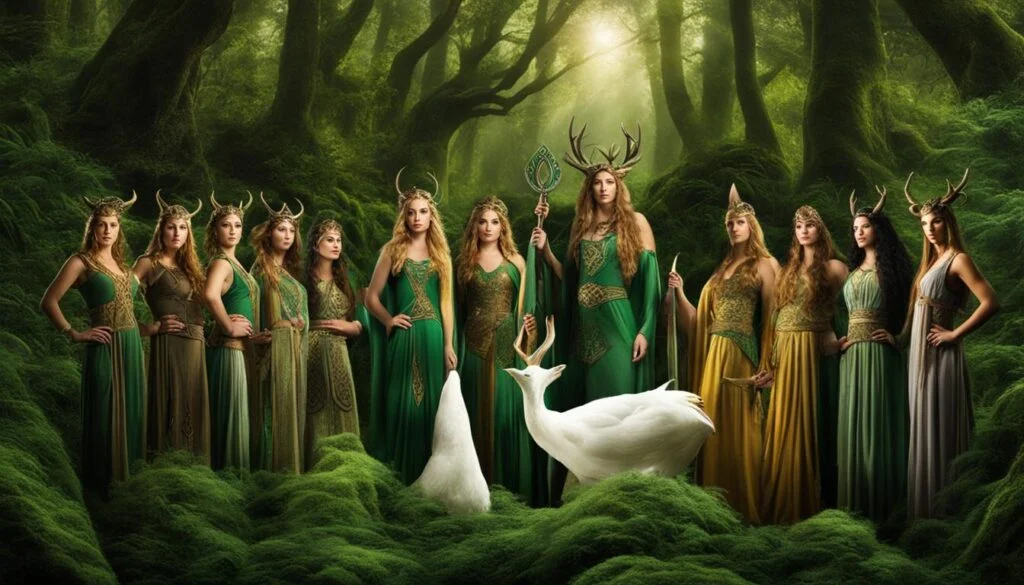Avalon, the mystical island that looms large in Arthurian legend, is steeped in mystery and fascination. In this article, we will delve into the rich tapestry of Avalon’s mythology and uncover its symbolic significance in the Arthurian mythos.
Key Takeaways:
- Avalon is a mythical island associated with King Arthur and the Lady of the Lake.
- It symbolizes magical and mystical practices, healing, and the eternal return of Arthur.
- The exact location of Avalon, whether it be Glastonbury Tor or elsewhere, remains uncertain.
- Avalon’s symbolism has inspired countless works of art, literature, and film.
- The quest for Avalon reflects our enduring fascination with mythical places and utopian paradises.
The Origins of Avalon in Arthurian Myth
Avalon, a prominent element in Arthurian legends, has its roots in Geoffrey of Monmouth’s Historia Regum Britanniae. In this renowned text, Avalon is depicted as a significant location where King Arthur’s famed sword Excalibur was forged and where Arthur sought solace and healing from his battle wounds.
As time went on, Avalon acquired deeper symbolism and became associated with mystical practices and magical figures, most notably Morgan le Fay. The concept of Arthur’s rest in Avalon under Morgan’s care gained popularity in medieval literature, further solidifying the island’s significance.
Beyond the physical realm, Avalon is often intertwined with the concept of the Otherworld, a supernatural domain inhabited by mythical beings and imbued with potent magic. This connection amplifies the symbolism of Avalon in Arthurian myths, emphasizing themes of enchantment, restoration, and the enduring cycle of Arthur’s return as the “once and future” king.
Throughout the Arthurian legends, Avalon’s symbolism reflects the profound influence of magic, the power of healing, and the eternal legacy of King Arthur. As we delve deeper into the mythical qualities of Avalon, we find a tapestry of enchantment that continues to captivate both our imaginations and our hearts.
Theories on the Location of Avalon

The exact location of Avalon remains uncertain. Some believe it is the former island of Glastonbury Tor, as it aligns with descriptions of Avalon as a place of magical qualities and abundance. Glastonbury Tor is associated with Arthurian legends and has a strong connection to Celtic and Christian traditions.
Other suggested locations for Avalon include the Isle of Man, where similar mythological beliefs of an apple island exist, and the island of Mallorca in Spain. The search for Avalon continues, fueled by the desire to find a physical place that embodies the mystical qualities of the legendary island.
Theories on the location of Avalon have fascinated scholars for centuries, as the symbolism of Avalon in Arthurian legends continues to captivate and intrigue.
Avalon’s Symbolism in Popular Culture

Avalon, with its rich symbolism in Arthurian myth, has left an indelible mark on popular culture. This mythical island has served as a wellspring of inspiration for countless novels, films, and art, captivating audiences across generations.
In popular culture, Avalon is often portrayed as a utopian paradise, a place where purity, abundance, and magic abound. It represents an idealized past, a bygone era when knights and their kings personified honor, bravery, and integrity.
The legends of Avalon have surpassed their original context and continue to resonate with people around the world. They offer an escape from reality, transporting us to a world that embodies timeless values and ignites a longing for a more enlightened existence.
Explore the enchanting allure of Avalon’s symbolism in the Arthurian myth, and delve into the realms of wonder and imagination that this mythical island embodies.
The Utopian Paradise
Avalon is often depicted as a realm of perfection, a place untouched by the flaws and imperfections of the mortal world. It symbolizes the yearning for an idyllic existence where harmony and tranquility reign supreme.
Ancient Magic and Mysticism
Avalon is renowned for its association with ancient magic and mystical practices. It evokes a sense of wonder and awe, alluding to the existence of supernatural forces beyond the realm of ordinary human experience.
Anchoring Values in an Ever-Changing World
Through its symbolism, Avalon preserves values such as honor, bravery, and integrity, transcending the boundaries of time and space. It serves as a reminder that these fundamental virtues are as relevant today as they were in the days of King Arthur.
An Escape into a Fabled Past
For those captivated by Avalon’s symbolism, it offers an escape into a fabled past, where chivalry and nobility were esteemed qualities. It allows us to immerse ourselves in a world of knights and quests, where dreams come alive and the extraordinary becomes possible.
Discover the enduring allure of Avalon’s symbolism and its impact on popular culture, as it continues to enchant and inspire us with its timeless themes.
The Enigmatic Name and Mythical Qualities of Avalon

The name Avalon is believed to have Welsh origins, meaning “Isle of Avallon” or “Isle of Fruit Trees.” It is associated with the Celtic belief in the magical properties of apples.
Avalon is often depicted as a place with bountiful apple trees and an abundance of natural resources. The island is also connected to the concept of the Otherworld, a realm of eternal youth and beauty.
Avalon’s mythical qualities symbolize the longing for a utopian paradise and the preservation of values such as purity, abundance, and eternal life.
The Role of Glastonbury Tor in Avalon’s Legend

Glastonbury Tor, located in England’s Somerset Levels, is a prominent theory for the location of the mystical Avalon. This rise of earth, steeped in history and myth, holds a significant association with Arthurian legends, including King Arthur and the Lady of the Lake. Many believe that Glastonbury Tor represents the physical embodiment of Avalon, aligning with descriptions of a magical and enchanting island.
The rich history of Glastonbury, its religious importance, and its connections to Arthurian myths have contributed to the belief that this iconic hill symbolizes the legendary Avalon. The intriguing allure of the Tor’s ancient ruins, coupled with its proximity to the mystical Glastonbury Abbey, further reinforces the association between Glastonbury Tor and the mythical realm of Avalon.
Embedded within the lush landscape of Glastonbury, the Tor serves as a visual testament to the captivating power of Arthurian mythology. Towering over the surrounding area, Glastonbury Tor casts an enchanting aura that beckons visitors to explore its mystical depths. Its prominence in the Avalon legend has made Glastonbury Tor a pilgrimage site for those seeking a connection to the magical world of Arthurian lore.
The Quest for Arthur’s Burial Place

The search for the burial place of King Arthur has long fascinated historians, archaeologists, and enthusiasts of Arthurian legends. Among the many theories, Glastonbury Abbey in England has claimed to have found Arthur’s tomb, igniting speculation that Avalon, the mythical island associated with King Arthur, is his final resting place.
The belief that Avalon is the burial place of King Arthur has historical significance, as it was fueled by political motivations and the desire to establish Arthur as a national hero. The connection between Avalon and Arthur’s final resting place adds to the mystique and enduring allure of Arthurian legends.
Glastonbury Abbey’s association with Arthurian legends has contributed to the belief that it holds the key to Arthur’s burial place. The discovery of an intricately inscribed sarcophagus at the abbey further perpetuates the idea that Arthur rests within its hallowed grounds.
The quest for Arthur’s burial place continues to captivate scholars and enthusiasts alike, as it represents the longing to unravel the mysteries of the past and shed light on the legendary figure of King Arthur. Whether Avalon is a physical location or merely a symbol, it remains an integral part of the Arthurian mythos and continues to fuel our fascination with the legendary king.
Alternative Theories and the Quest for Avalon

Alongside Glastonbury, other locations have been proposed as the possible site of Avalon. These include the Isle of Man, which shares similarities with Avalon in terms of mythology and the association with apples. Other theories suggest connections between Avalon and Celtic and Scandinavian mythologies, such as the realms of the dead in these belief systems. The enduring quest for Avalon reflects humanity’s fascination with mythical places and the desire to find a physical manifestation of a utopian paradise.
- The Isle of Man: With its enchanting landscapes and folklore, the Isle of Man has been suggested as a possible location for Avalon. This island is associated with similar mythological beliefs surrounding an apple island, just like Avalon. The connection between the two further fuels the quest for the mystical land.
- Celtic and Scandinavian Mythologies: Some theories link Avalon to Celtic and Scandinavian mythologies, specifically the realms of the dead. These mythologies feature paradisiacal realms where heroes and legends are believed to reside after death. Avalon, with its symbolic significance and association with Arthurian legends, aligns with the concept of these mythological realms.
The search for Avalon continues to captivate and intrigue, drawing people to explore various locations and mythological connections. It reflects humanity’s fascination with mythical places and the eternal quest for a tangible manifestation of a utopian paradise. The enduring allure of Avalon symbolism in legends and its significance in Arthurian myths contribute to its ongoing exploration and the exploration of alternative theories.
Conclusion
The legends of Avalon in Arthurian myth continue to captivate and intrigue us. Avalon symbolizes an idealized past, a utopian paradise, and the preservation of values such as purity, abundance, and magic. Whether Avalon is a physical location or a mythical realm, its significance in Arthurian myth and popular culture endures. The enduring quest for Avalon reflects our longing for a world that embodies the timeless values of honor, bravery, and integrity.
Avalon’s mythical qualities and its association with Arthurian legend have had a profound impact on popular culture. From novels to films to art, the enchanting allure of Avalon continues to inspire and transport audiences to a world where knights and their kings represent honor, bravery, and integrity.
While the search for the physical location of Avalon remains uncertain, the fascination and quest for this legendary island persist. Avalon serves as a potent symbol of humanity’s longing for a utopian paradise, a place where purity, abundance, and eternal life are preserved. Whether Avalon exists as a physical place or a realm of the imagination, its enduring significance in our collective consciousness will continue to captivate and inspire generations to come.
FAQ
What is Avalon?
Avalon is a mythical island in the Arthurian legend that is associated with King Arthur, the Lady of the Lake, and the nine sisters. It is often seen as a symbol of Arthurian mythology and is connected to the story of Arthur’s sword Excalibur and his rest in Avalon to heal from battle wounds.
Where did Avalon first appear?
Avalon first appeared in Geoffrey of Monmouth’s Historia Regum Britanniae, where it was described as a place where Excalibur was forged and where Arthur was taken to recover from his battle injuries.
Where is the exact location of Avalon?
The exact location of Avalon remains uncertain. Some theories suggest the former island of Glastonbury Tor in England, while others propose the Isle of Man or the island of Mallorca in Spain as possible locations.
What does Avalon symbolize in Arthurian myths?
Avalon symbolizes themes of magic, healing, and the eternal return of King Arthur as the “once and future” king.
How has Avalon impacted popular culture?
Avalon has inspired numerous novels, films, and artwork, often depicted as a utopian paradise and a symbol of an idealized past and timeless values.
What is the meaning of the name Avalon?
The name Avalon is believed to have Welsh origins, meaning “Isle of Avallon” or “Isle of Fruit Trees,” associated with the Celtic belief in the magical properties of apples.
What is the role of Glastonbury Tor in Avalon’s legend?
Glastonbury Tor in England is a popular theory for the location of Avalon, with its associations with the legend of King Arthur, the Lady of the Lake, and its alignment with descriptions of a magical and mystical island.
What is the quest for Arthur’s burial place?
The burial place of King Arthur has been a subject of speculation, with Glastonbury Abbey claiming to have found Arthur’s tomb. The search for Arthur’s burial place has historical significance and adds to the mystique of Avalon and Arthurian legends.
Are there alternative theories about Avalon’s location?
Yes, besides Glastonbury Tor, other proposed locations for Avalon include the Isle of Man and theories connecting Avalon to Celtic and Scandinavian mythologies.
What is the significance of Avalon in Arthurian myth?
Avalon symbolizes an idealized past, a utopian paradise, and the preservation of values such as purity, abundance, and magic in Arthurian myth.




